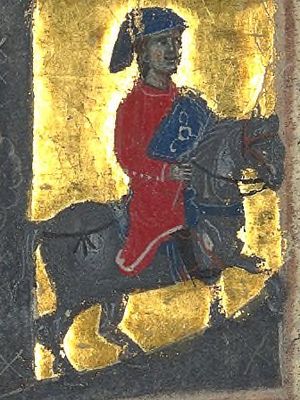Guillem de Cabestany facts for kids
Guillem de Cabestany (born around 1162, died 1212) was a famous Catalan troubadour. A troubadour was a poet and musician who wrote and performed songs, often about love and chivalry, in the Middle Ages. Guillem came from a place called Cabestany in the County of Roussillon, which is now part of France, near the Spanish border. He is also known by his Old Occitan name, Guilhem de Cabestaing.
Contents
His Life
We don't have a lot of exact details about Guillem de Cabestany's life. He was likely the son of Arnau de Cabestany, a nobleman from Roussillon. His family probably served the lords of Castell Rosselló. Cabestany was a small area of land (a fief) very close to Castell Rosselló.
Some historical accounts say that Guillem de Cabestany fought alongside Peter II of Aragon, a king, in a big battle called the Battle of Las Navas de Tolosa in 1212. This battle was against a group called the Almohads.
The Famous Legend
Guillem de Cabestany is most famous because of a sad and dramatic legend about him. This story is called a vida, which means "life" in Old Occitan, but these vidas often mixed facts with fiction.
According to the legend, Guillem was secretly in love with a woman named Seremonda (sometimes called Margarida). She was married to Raimon of Castell Rosselló. When Raimon found out about their secret love, he became very angry. The legend says he took a terrible revenge. After this, Seremonda was so heartbroken that she chose to end her life.
This tragic story became very popular and was told in many different ways. It inspired famous writers like Giovanni Boccaccio in his book Decameron and Stendhal in On Love. The poet Ezra Pound also included parts of the legend in his work, Canto IV. More recently, it even inspired an opera called Written on Skin in 2012.
Historians have found at least fourteen different versions of this kind of "eaten heart" legend in various stories from different cultures. So, Guillem de Cabestany's story might be one of many similar tales.
His Works
Guillem de Cabestany was a poet and songwriter. Some of his poems were first published a long time ago in 1816.
Today, we know of nine songs that are believed to have been written by Cabestany. Two of these are not completely certain, but the others are definitely his. His works have been published in books that show both the original Old Occitan language and a modern French translation.
See also
 In Spanish: Guillem de Cabestany para niños
In Spanish: Guillem de Cabestany para niños


